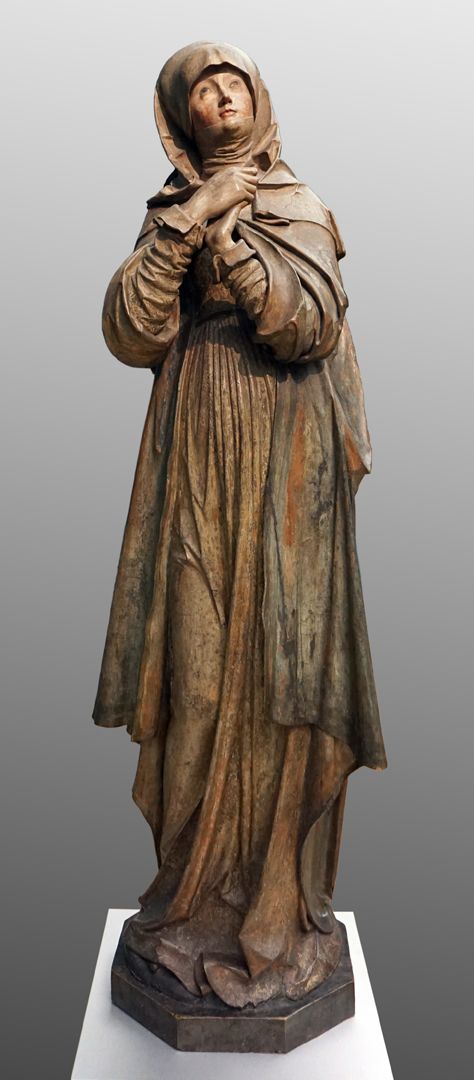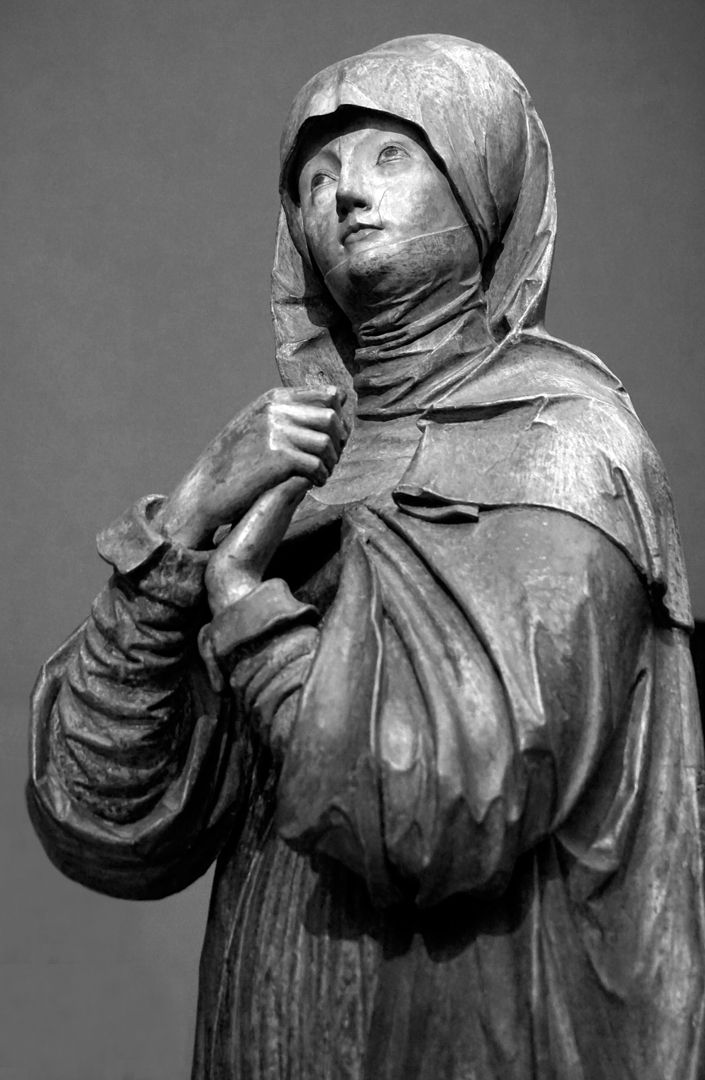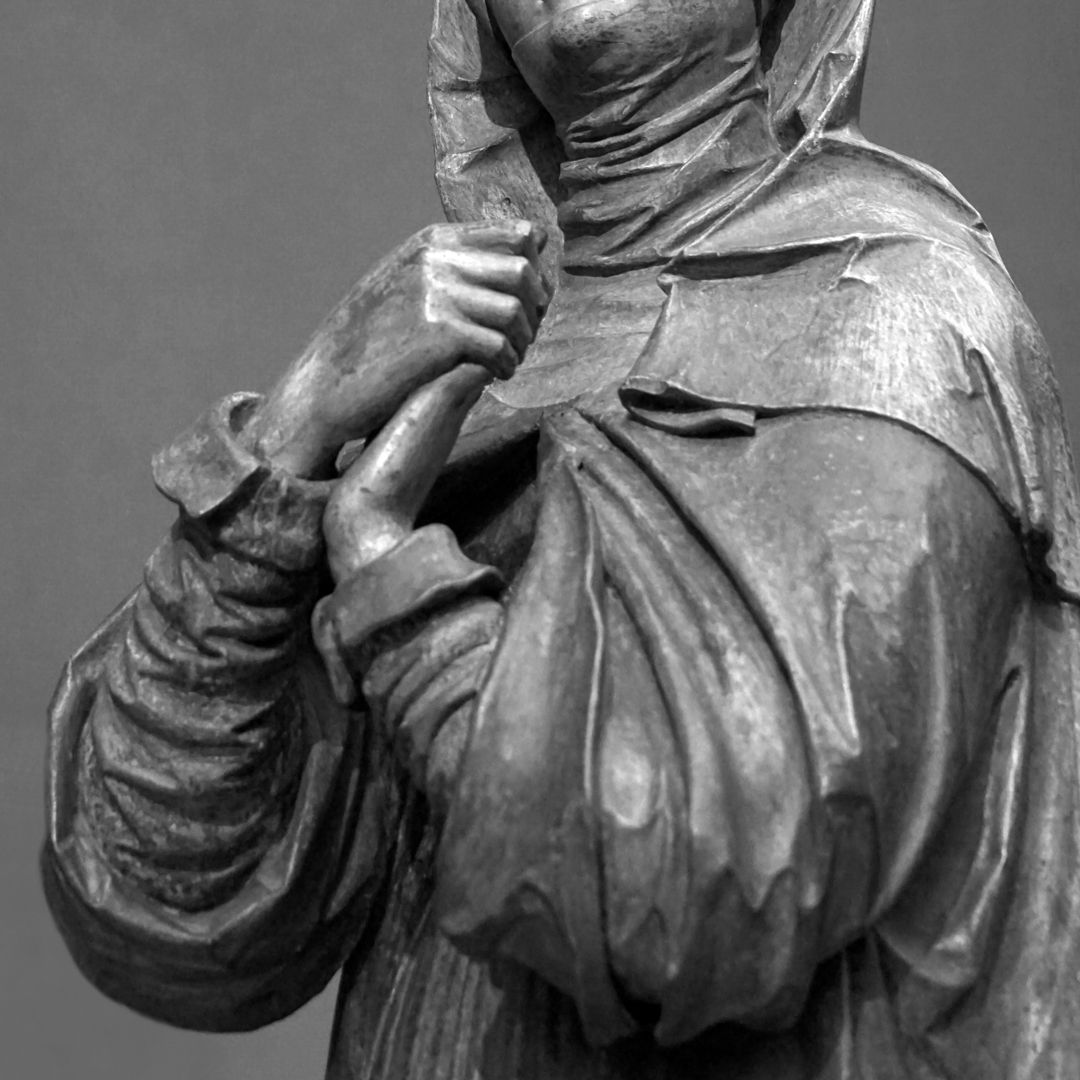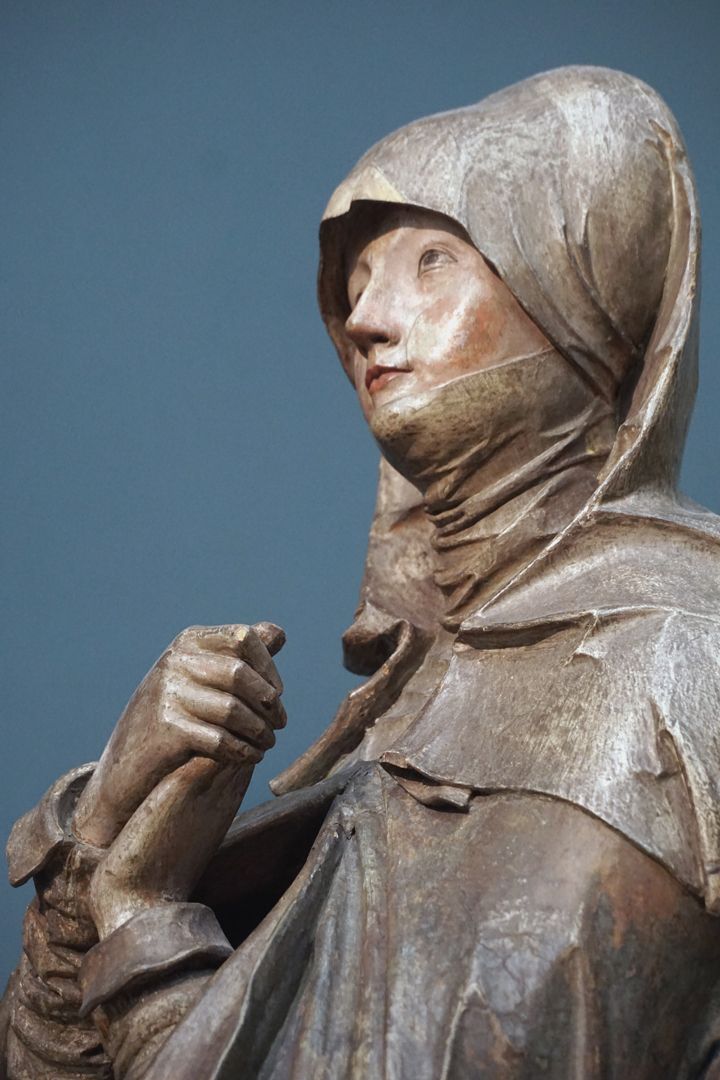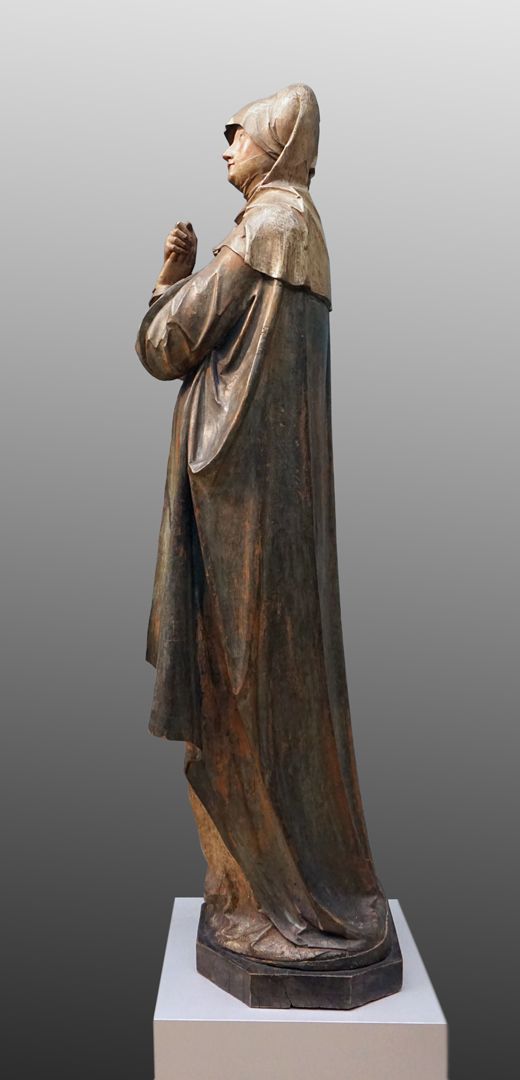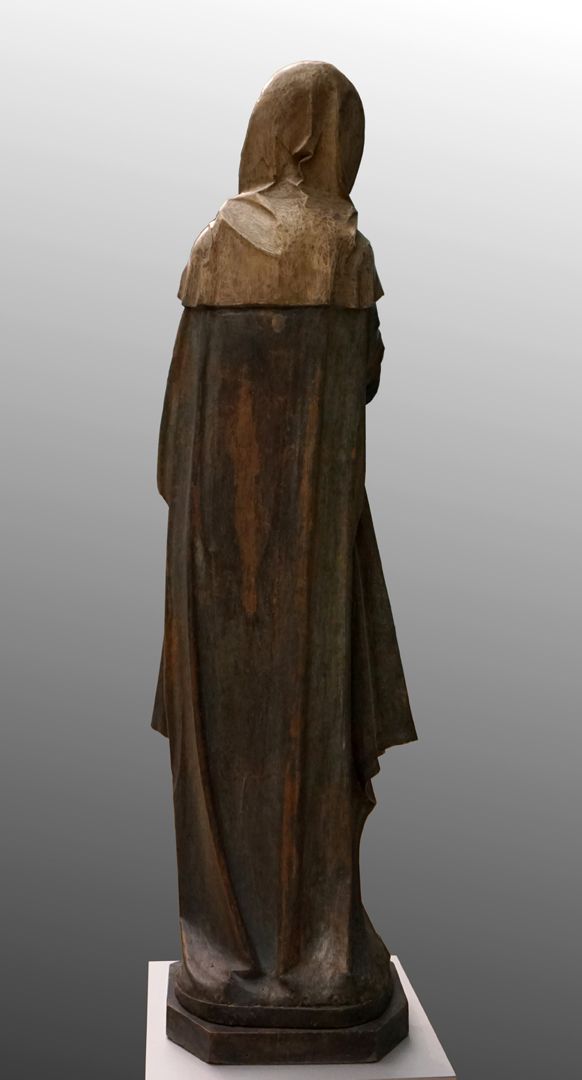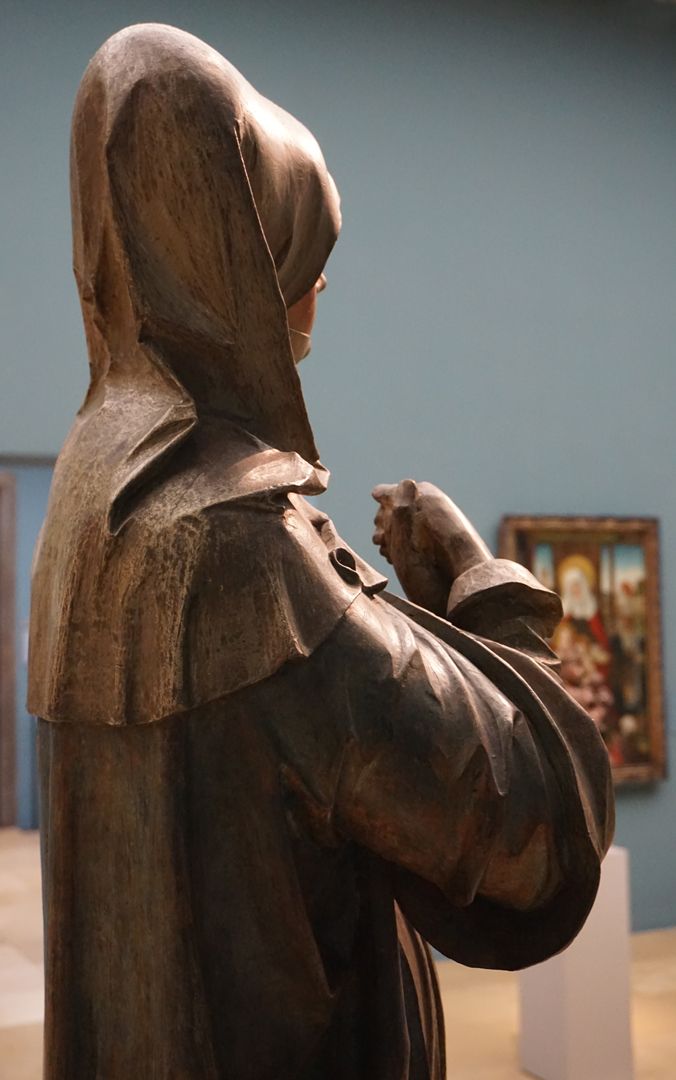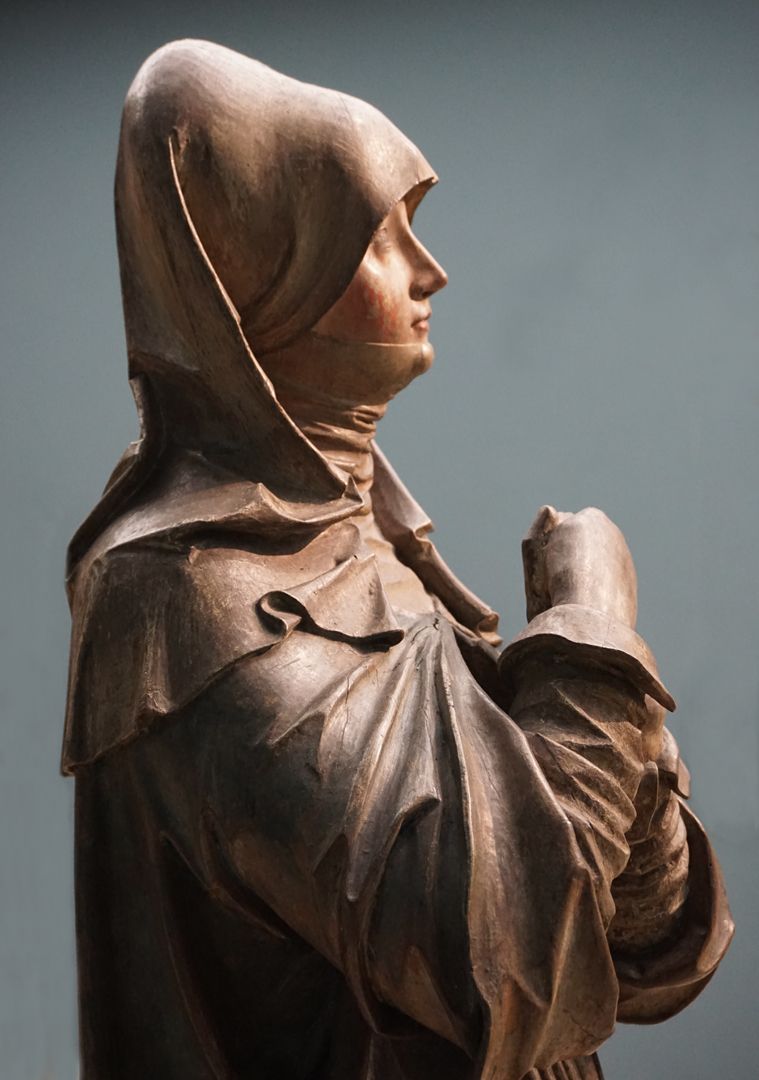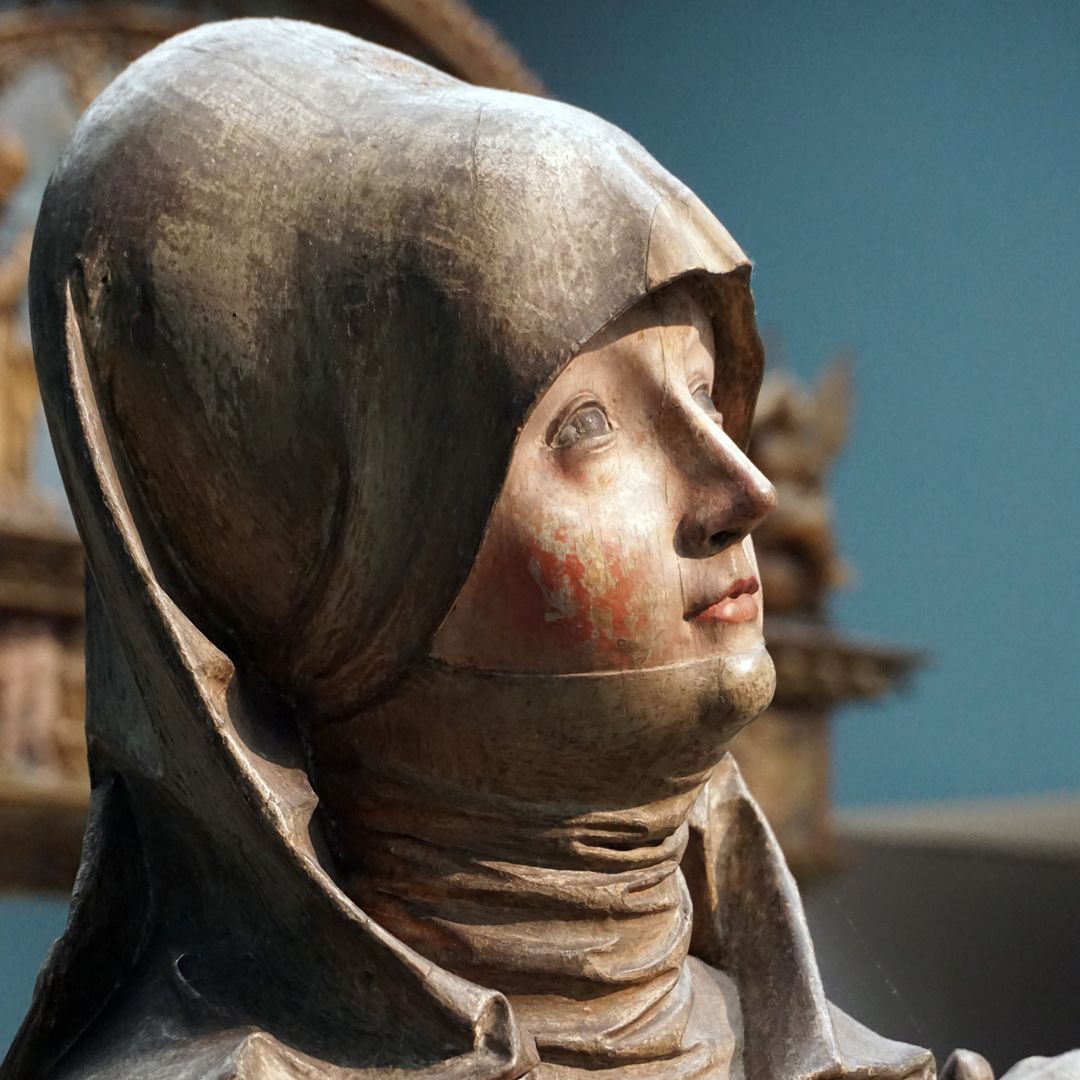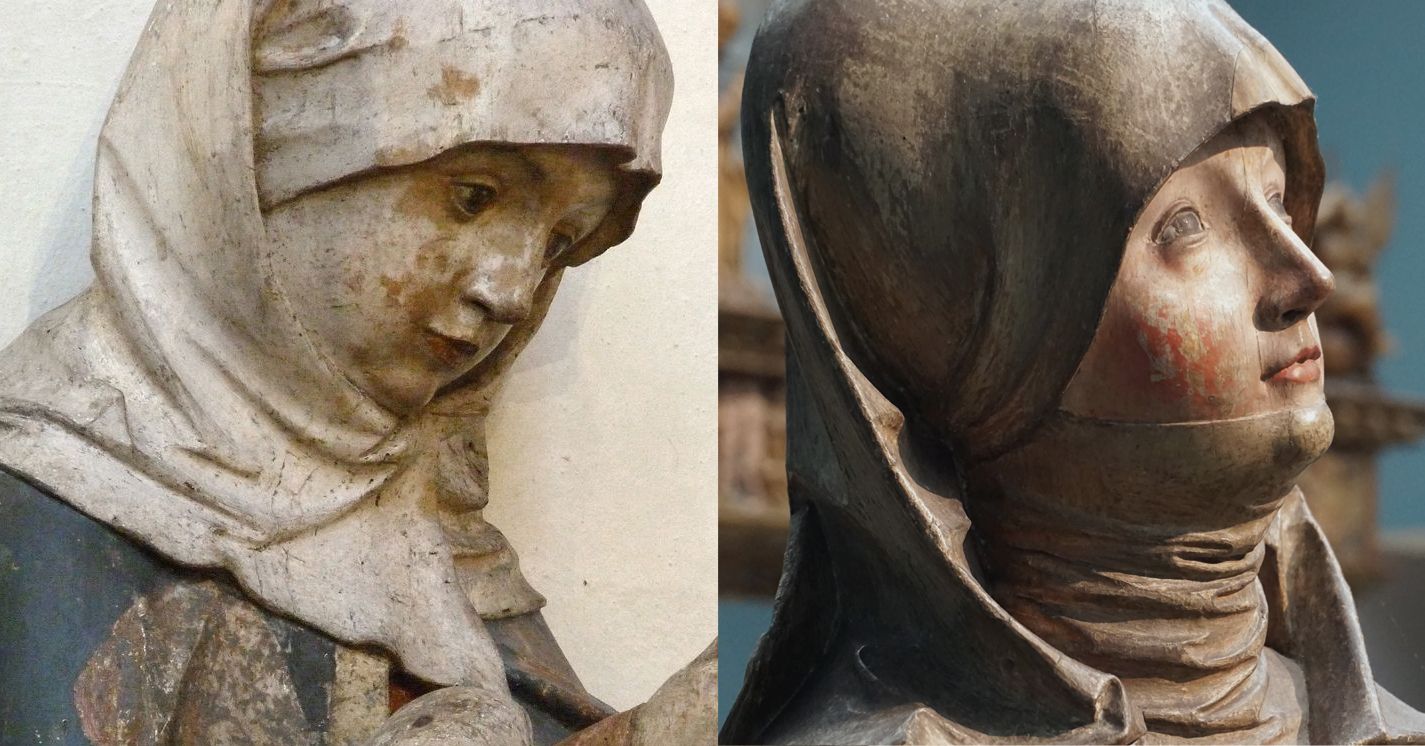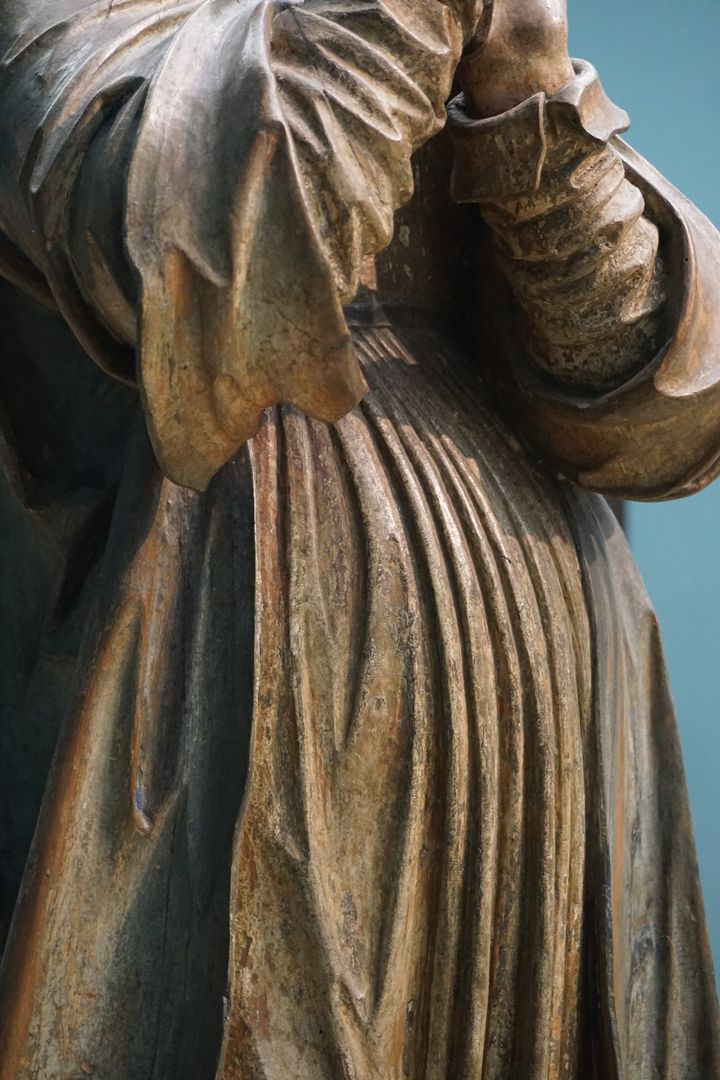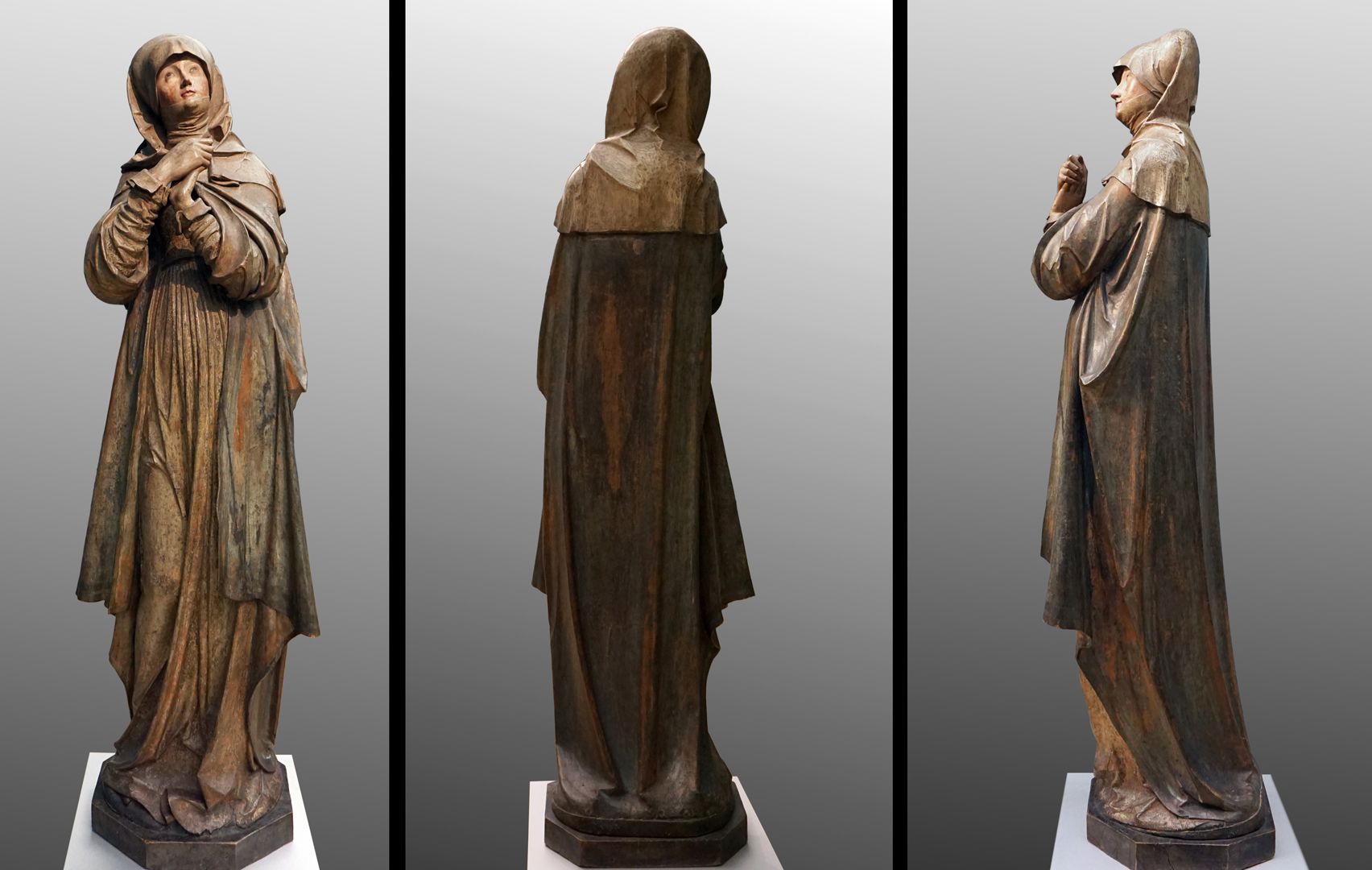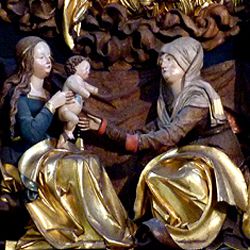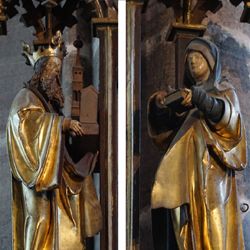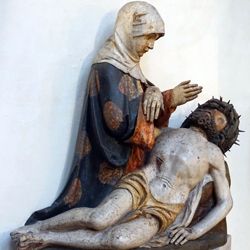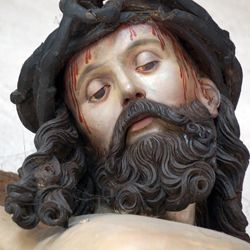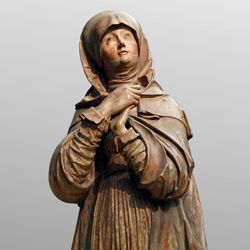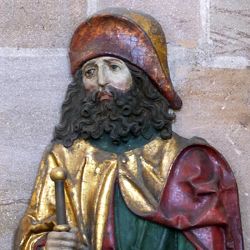Nuremberg Madonna
Nuremberg Madonna
around 1515
Master Jörg and Workshop
"The folds of the heavily elongated figure's robe flow thinly and tautly upwards, just as her hands wringing in a pathetic gesture in front of her chest and the position of her head lead her gaze upwards. Her swelling silhouette and the finely tuned interplay of horizontal, vertical and diagonal axes of movement and composition set the slender figure into delicate vertical oscillations. The proportions are impossible to reconcile with the massive Brucke shrine saints. Yet the figures of the Annengruppe in Lorenz, whose heads sit on comparably long necks, are clearly more elongated. The childlike type of the face, which refrains from any signs of mourning, is very close to that of the Maria of the Little Pietà. She also has elegiac sentiment in common with her. Despite its almost ethereal appearance, the sculpture remains strikingly physical and plastic. The same applies to the design of the coat with the small sweeps of the hem edges and the emphatically two-dimensional sections which, like the loosely falling veil of the bonnet, are defined in the shoulder area by the familiar thin, forking, now even more graphic and energetic-looking folds. Broken or thicker folds are now almost completely absent. Instead, where the fabric is pushed together at the neck and sleeves of the dress, there is a quantitative compression of the fine-grained folds into honeycomb-like motifs. We know all this in a similar form from the Annenschrein, the Little Pietà or the Christ figures in Bruck and especially in St. Jobst, although formally simpler and more reduced than in the Nuremberg Madonna.
Stefan Roller, Hans von Kulmbach und der Nürnberger Bildschnitzer Meister Jörg, in: Renaissance in Franken.
Hans von Kulmbach and the Art around Dürer, Petersberg 2022, p.121
see also: Crucifix from St. Jobst
Location: Nuremberg, GNM, inventory number Pl.O.210
Design: Herb (Meister Jörg Pildschnitzer), Georg
Realization: Herb (Meister Jörg Pildschnitzer), Georg
photo 2022, Theo Noll
Nuremberg Madonna
around 1515
Detailed view
Master Jörg and Workshop
"The folds of the heavily elongated figure's robe flow thinly and tautly upwards, just as her hands wringing in a pathetic gesture in front of her chest and the position of her head lead her gaze upwards. Her swelling silhouette and the finely tuned interplay of horizontal, vertical and diagonal axes of movement and composition set the slender figure into delicate vertical oscillations. The proportions are impossible to reconcile with the massive Brucke shrine saints. Yet the figures of the Annengruppe in Lorenz, whose heads sit on comparably long necks, are clearly more elongated. The childlike type of the face, which refrains from any signs of mourning, is very close to that of the Maria of the Little Pietà. She also has elegiac sentiment in common with her. Despite its almost ethereal appearance, the sculpture remains strikingly physical and plastic. The same applies to the design of the coat with the small sweeps of the hem edges and the emphatically two-dimensional sections which, like the loosely falling veil of the bonnet, are defined in the shoulder area by the familiar thin, forking, now even more graphic and energetic-looking folds. Broken or thicker folds are now almost completely absent. Instead, where the fabric is pushed together at the neck and sleeves of the dress, there is a quantitative compression of the fine-grained folds into honeycomb-like motifs. We know all this in a similar form from the Annenschrein, the Little Pietà or the Christ figures in Bruck and especially in St. Jobst, although formally simpler and more reduced than in the Nuremberg Madonna.
Stefan Roller, Hans von Kulmbach und der Nürnberger Bildschnitzer Meister Jörg, in: Renaissance in Franken.
Hans von Kulmbach and the Art around Dürer, Petersberg 2022, p.121
see also: Crucifix from St. Jobst
Location: Nuremberg, GNM, inventory number Pl.O.210
Design: Herb (Meister Jörg Pildschnitzer), Georg
Realization: Herb (Meister Jörg Pildschnitzer), Georg
photo 2022, Theo Noll
Nuremberg Madonna
around 1515
Detaild view with folds of the gown
Master Jörg and Workshop
"The folds of the heavily elongated figure's robe flow thinly and tautly upwards, just as her hands wringing in a pathetic gesture in front of her chest and the position of her head lead her gaze upwards. Her swelling silhouette and the finely tuned interplay of horizontal, vertical and diagonal axes of movement and composition set the slender figure into delicate vertical oscillations. The proportions are impossible to reconcile with the massive Brucke shrine saints. Yet the figures of the Annengruppe in Lorenz, whose heads sit on comparably long necks, are clearly more elongated. The childlike type of the face, which refrains from any signs of mourning, is very close to that of the Maria of the Little Pietà. She also has elegiac sentiment in common with her. Despite its almost ethereal appearance, the sculpture remains strikingly physical and plastic. The same applies to the design of the coat with the small sweeps of the hem edges and the emphatically two-dimensional sections which, like the loosely falling veil of the bonnet, are defined in the shoulder area by the familiar thin, forking, now even more graphic and energetic-looking folds. Broken or thicker folds are now almost completely absent. Instead, where the fabric is pushed together at the neck and sleeves of the dress, there is a quantitative compression of the fine-grained folds into honeycomb-like motifs. We know all this in a similar form from the Annenschrein, the Little Pietà or the Christ figures in Bruck and especially in St. Jobst, although formally simpler and more reduced than in the Nuremberg Madonna.
Stefan Roller, Hans von Kulmbach und der Nürnberger Bildschnitzer Meister Jörg, in: Renaissance in Franken.
Hans von Kulmbach and the Art around Dürer, Petersberg 2022, p.121
see also: Crucifix from St. Jobst
Location: Nuremberg, GNM, inventory number Pl.O.210
Design: Herb (Meister Jörg Pildschnitzer), Georg
Realization: Herb (Meister Jörg Pildschnitzer), Georg
photo 2022, Theo Noll
Nuremberg Madonna
around 1515
Detailed view
Master Jörg and Workshop
"The folds of the heavily elongated figure's robe flow thinly and tautly upwards, just as her hands wringing in a pathetic gesture in front of her chest and the position of her head lead her gaze upwards. Her swelling silhouette and the finely tuned interplay of horizontal, vertical and diagonal axes of movement and composition set the slender figure into delicate vertical oscillations. The proportions are impossible to reconcile with the massive Brucke shrine saints. Yet the figures of the Annengruppe in Lorenz, whose heads sit on comparably long necks, are clearly more elongated. The childlike type of the face, which refrains from any signs of mourning, is very close to that of the Maria of the Little Pietà. She also has elegiac sentiment in common with her. Despite its almost ethereal appearance, the sculpture remains strikingly physical and plastic. The same applies to the design of the coat with the small sweeps of the hem edges and the emphatically two-dimensional sections which, like the loosely falling veil of the bonnet, are defined in the shoulder area by the familiar thin, forking, now even more graphic and energetic-looking folds. Broken or thicker folds are now almost completely absent. Instead, where the fabric is pushed together at the neck and sleeves of the dress, there is a quantitative compression of the fine-grained folds into honeycomb-like motifs. We know all this in a similar form from the Annenschrein, the Little Pietà or the Christ figures in Bruck and especially in St. Jobst, although formally simpler and more reduced than in the Nuremberg Madonna.
Stefan Roller, Hans von Kulmbach und der Nürnberger Bildschnitzer Meister Jörg, in: Renaissance in Franken.
Hans von Kulmbach and the Art around Dürer, Petersberg 2022, p.121
see also: Crucifix from St. Jobst
Location: Nuremberg, GNM, inventory number Pl.O.210
Design: Herb (Meister Jörg Pildschnitzer), Georg
Realization: Herb (Meister Jörg Pildschnitzer), Georg
photo 2022, Theo Noll
Nuremberg Madonna
around 1515
Side view
Master Jörg and Workshop
"The folds of the heavily elongated figure's robe flow thinly and tautly upwards, just as her hands wringing in a pathetic gesture in front of her chest and the position of her head lead her gaze upwards. Her swelling silhouette and the finely tuned interplay of horizontal, vertical and diagonal axes of movement and composition set the slender figure into delicate vertical oscillations. The proportions are impossible to reconcile with the massive Brucke shrine saints. Yet the figures of the Annengruppe in Lorenz, whose heads sit on comparably long necks, are clearly more elongated. The childlike type of the face, which refrains from any signs of mourning, is very close to that of the Maria of the Little Pietà. She also has elegiac sentiment in common with her. Despite its almost ethereal appearance, the sculpture remains strikingly physical and plastic. The same applies to the design of the coat with the small sweeps of the hem edges and the emphatically two-dimensional sections which, like the loosely falling veil of the bonnet, are defined in the shoulder area by the familiar thin, forking, now even more graphic and energetic-looking folds. Broken or thicker folds are now almost completely absent. Instead, where the fabric is pushed together at the neck and sleeves of the dress, there is a quantitative compression of the fine-grained folds into honeycomb-like motifs. We know all this in a similar form from the Annenschrein, the Little Pietà or the Christ figures in Bruck and especially in St. Jobst, although formally simpler and more reduced than in the Nuremberg Madonna.
Stefan Roller, Hans von Kulmbach und der Nürnberger Bildschnitzer Meister Jörg, in: Renaissance in Franken.
Hans von Kulmbach and the Art around Dürer, Petersberg 2022, p.121
see also: Crucifix from St. Jobst
Location: Nuremberg, GNM, inventory number Pl.O.210
Design: Herb (Meister Jörg Pildschnitzer), Georg
Realization: Herb (Meister Jörg Pildschnitzer), Georg
photo 2022, Theo Noll
Nuremberg Madonna
around 1515
Rear view
Master Jörg and Workshop
"The folds of the heavily elongated figure's robe flow thinly and tautly upwards, just as her hands wringing in a pathetic gesture in front of her chest and the position of her head lead her gaze upwards. Her swelling silhouette and the finely tuned interplay of horizontal, vertical and diagonal axes of movement and composition set the slender figure into delicate vertical oscillations. The proportions are impossible to reconcile with the massive Brucke shrine saints. Yet the figures of the Annengruppe in Lorenz, whose heads sit on comparably long necks, are clearly more elongated. The childlike type of the face, which refrains from any signs of mourning, is very close to that of the Maria of the Little Pietà. She also has elegiac sentiment in common with her. Despite its almost ethereal appearance, the sculpture remains strikingly physical and plastic. The same applies to the design of the coat with the small sweeps of the hem edges and the emphatically two-dimensional sections which, like the loosely falling veil of the bonnet, are defined in the shoulder area by the familiar thin, forking, now even more graphic and energetic-looking folds. Broken or thicker folds are now almost completely absent. Instead, where the fabric is pushed together at the neck and sleeves of the dress, there is a quantitative compression of the fine-grained folds into honeycomb-like motifs. We know all this in a similar form from the Annenschrein, the Little Pietà or the Christ figures in Bruck and especially in St. Jobst, although formally simpler and more reduced than in the Nuremberg Madonna.
Stefan Roller, Hans von Kulmbach und der Nürnberger Bildschnitzer Meister Jörg, in: Renaissance in Franken.
Hans von Kulmbach and the Art around Dürer, Petersberg 2022, p.121
see also: Crucifix from St. Jobst
Location: Nuremberg, GNM, inventory number Pl.O.210
Design: Herb (Meister Jörg Pildschnitzer), Georg
Realization: Herb (Meister Jörg Pildschnitzer), Georg
photo 2022, Theo Noll
Nuremberg Madonna
around 1515
Detailed view
Master Jörg and Workshop
"The folds of the heavily elongated figure's robe flow thinly and tautly upwards, just as her hands wringing in a pathetic gesture in front of her chest and the position of her head lead her gaze upwards. Her swelling silhouette and the finely tuned interplay of horizontal, vertical and diagonal axes of movement and composition set the slender figure into delicate vertical oscillations. The proportions are impossible to reconcile with the massive Brucke shrine saints. Yet the figures of the Annengruppe in Lorenz, whose heads sit on comparably long necks, are clearly more elongated. The childlike type of the face, which refrains from any signs of mourning, is very close to that of the Maria of the Little Pietà. She also has elegiac sentiment in common with her. Despite its almost ethereal appearance, the sculpture remains strikingly physical and plastic. The same applies to the design of the coat with the small sweeps of the hem edges and the emphatically two-dimensional sections which, like the loosely falling veil of the bonnet, are defined in the shoulder area by the familiar thin, forking, now even more graphic and energetic-looking folds. Broken or thicker folds are now almost completely absent. Instead, where the fabric is pushed together at the neck and sleeves of the dress, there is a quantitative compression of the fine-grained folds into honeycomb-like motifs. We know all this in a similar form from the Annenschrein, the Little Pietà or the Christ figures in Bruck and especially in St. Jobst, although formally simpler and more reduced than in the Nuremberg Madonna.
Stefan Roller, Hans von Kulmbach und der Nürnberger Bildschnitzer Meister Jörg, in: Renaissance in Franken.
Hans von Kulmbach and the Art around Dürer, Petersberg 2022, p.121
see also: Crucifix from St. Jobst
Location: Nuremberg, GNM, inventory number Pl.O.210
Design: Herb (Meister Jörg Pildschnitzer), Georg
Realization: Herb (Meister Jörg Pildschnitzer), Georg
photo 2022, Theo Noll
Nuremberg Madonna
around 1515
Detailansicht
Master Jörg and Workshop
"The folds of the heavily elongated figure's robe flow thinly and tautly upwards, just as her hands wringing in a pathetic gesture in front of her chest and the position of her head lead her gaze upwards. Her swelling silhouette and the finely tuned interplay of horizontal, vertical and diagonal axes of movement and composition set the slender figure into delicate vertical oscillations. The proportions are impossible to reconcile with the massive Brucke shrine saints. Yet the figures of the Annengruppe in Lorenz, whose heads sit on comparably long necks, are clearly more elongated. The childlike type of the face, which refrains from any signs of mourning, is very close to that of the Maria of the Little Pietà. She also has elegiac sentiment in common with her. Despite its almost ethereal appearance, the sculpture remains strikingly physical and plastic. The same applies to the design of the coat with the small sweeps of the hem edges and the emphatically two-dimensional sections which, like the loosely falling veil of the bonnet, are defined in the shoulder area by the familiar thin, forking, now even more graphic and energetic-looking folds. Broken or thicker folds are now almost completely absent. Instead, where the fabric is pushed together at the neck and sleeves of the dress, there is a quantitative compression of the fine-grained folds into honeycomb-like motifs. We know all this in a similar form from the Annenschrein, the Little Pietà or the Christ figures in Bruck and especially in St. Jobst, although formally simpler and more reduced than in the Nuremberg Madonna.
Stefan Roller, Hans von Kulmbach und der Nürnberger Bildschnitzer Meister Jörg, in: Renaissance in Franken.
Hans von Kulmbach and the Art around Dürer, Petersberg 2022, p.121
see also: Crucifix from St. Jobst
Location: Nürnberg, GNM, Inventarnummer Pl.O.210
Design: Herb (Meister Jörg Pildschnitzer), Georg
Realization: Herb (Meister Jörg Pildschnitzer), Georg
photo 2022, Theo Noll
Nuremberg Madonna
around 1515
Detailed view
Master Jörg and Workshop
"The folds of the heavily elongated figure's robe flow thinly and tautly upwards, just as her hands wringing in a pathetic gesture in front of her chest and the position of her head lead her gaze upwards. Her swelling silhouette and the finely tuned interplay of horizontal, vertical and diagonal axes of movement and composition set the slender figure into delicate vertical oscillations. The proportions are impossible to reconcile with the massive Brucke shrine saints. Yet the figures of the Annengruppe in Lorenz, whose heads sit on comparably long necks, are clearly more elongated. The childlike type of the face, which refrains from any signs of mourning, is very close to that of the Maria of the Little Pietà. She also has elegiac sentiment in common with her. Despite its almost ethereal appearance, the sculpture remains strikingly physical and plastic. The same applies to the design of the coat with the small sweeps of the hem edges and the emphatically two-dimensional sections which, like the loosely falling veil of the bonnet, are defined in the shoulder area by the familiar thin, forking, now even more graphic and energetic-looking folds. Broken or thicker folds are now almost completely absent. Instead, where the fabric is pushed together at the neck and sleeves of the dress, there is a quantitative compression of the fine-grained folds into honeycomb-like motifs. We know all this in a similar form from the Annenschrein, the Little Pietà or the Christ figures in Bruck and especially in St. Jobst, although formally simpler and more reduced than in the Nuremberg Madonna.
Stefan Roller, Hans von Kulmbach und der Nürnberger Bildschnitzer Meister Jörg, in: Renaissance in Franken.
Hans von Kulmbach and the Art around Dürer, Petersberg 2022, p.121
see also: Crucifix from St. Jobst
Location: Nuremberg, GNM, inventory number Pl.O.210
Design: Herb (Meister Jörg Pildschnitzer), Georg
Realization: Herb (Meister Jörg Pildschnitzer), Georg
photo 2022, Theo Noll
Nuremberg Madonna
around 1515
Comparison of images: left Maria, Small Pietà in St. Jacob's Church / right Nuremberg Madonna
Master Jörg and Workshop
"The folds of the heavily elongated figure's robe flow thinly and tautly upwards, just as her hands wringing in a pathetic gesture in front of her chest and the position of her head lead her gaze upwards. Her swelling silhouette and the finely tuned interplay of horizontal, vertical and diagonal axes of movement and composition set the slender figure into delicate vertical oscillations. The proportions are impossible to reconcile with the massive Brucke shrine saints. Yet the figures of the Annengruppe in Lorenz, whose heads sit on comparably long necks, are clearly more elongated. The childlike type of the face, which refrains from any signs of mourning, is very close to that of the Maria of the Little Pietà. She also has elegiac sentiment in common with her. Despite its almost ethereal appearance, the sculpture remains strikingly physical and plastic. The same applies to the design of the coat with the small sweeps of the hem edges and the emphatically two-dimensional sections which, like the loosely falling veil of the bonnet, are defined in the shoulder area by the familiar thin, forking, now even more graphic and energetic-looking folds. Broken or thicker folds are now almost completely absent. Instead, where the fabric is pushed together at the neck and sleeves of the dress, there is a quantitative compression of the fine-grained folds into honeycomb-like motifs. We know all this in a similar form from the Annenschrein, the Little Pietà or the Christ figures in Bruck and especially in St. Jobst, although formally simpler and more reduced than in the Nuremberg Madonna.
Stefan Roller, Hans von Kulmbach und der Nürnberger Bildschnitzer Meister Jörg, in: Renaissance in Franken.
Hans von Kulmbach and the Art around Dürer, Petersberg 2022, p.121
see also: Crucifix from St. Jobst
Location: Nuremberg, GNM, inventory number Pl.O.210
Design: Herb (Meister Jörg Pildschnitzer), Georg
Realization: Herb (Meister Jörg Pildschnitzer), Georg
photo 2022, Theo Noll
Nuremberg Madonna
around 1515
Detailed view
Master Jörg and Workshop
"The folds of the heavily elongated figure's robe flow thinly and tautly upwards, just as her hands wringing in a pathetic gesture in front of her chest and the position of her head lead her gaze upwards. Her swelling silhouette and the finely tuned interplay of horizontal, vertical and diagonal axes of movement and composition set the slender figure into delicate vertical oscillations. The proportions are impossible to reconcile with the massive Brucke shrine saints. Yet the figures of the Annengruppe in Lorenz, whose heads sit on comparably long necks, are clearly more elongated. The childlike type of the face, which refrains from any signs of mourning, is very close to that of the Maria of the Little Pietà. She also has elegiac sentiment in common with her. Despite its almost ethereal appearance, the sculpture remains strikingly physical and plastic. The same applies to the design of the coat with the small sweeps of the hem edges and the emphatically two-dimensional sections which, like the loosely falling veil of the bonnet, are defined in the shoulder area by the familiar thin, forking, now even more graphic and energetic-looking folds. Broken or thicker folds are now almost completely absent. Instead, where the fabric is pushed together at the neck and sleeves of the dress, there is a quantitative compression of the fine-grained folds into honeycomb-like motifs. We know all this in a similar form from the Annenschrein, the Little Pietà or the Christ figures in Bruck and especially in St. Jobst, although formally simpler and more reduced than in the Nuremberg Madonna.
Stefan Roller, Hans von Kulmbach und der Nürnberger Bildschnitzer Meister Jörg, in: Renaissance in Franken.
Hans von Kulmbach and the Art around Dürer, Petersberg 2022, p.121
see also: Crucifix from St. Jobst
Location: Nuremberg, GNM, inventory number Pl.O.210
Design: Herb (Meister Jörg Pildschnitzer), Georg
Realization: Herb (Meister Jörg Pildschnitzer), Georg
photo 2022, Theo Noll
Nuremberg Madonna
around 1515
Side views
Master Jörg and Workshop
"The folds of the heavily elongated figure's robe flow thinly and tautly upwards, just as her hands wringing in a pathetic gesture in front of her chest and the position of her head lead her gaze upwards. Her swelling silhouette and the finely tuned interplay of horizontal, vertical and diagonal axes of movement and composition set the slender figure into delicate vertical oscillations. The proportions are impossible to reconcile with the massive Brucke shrine saints. Yet the figures of the Annengruppe in Lorenz, whose heads sit on comparably long necks, are clearly more elongated. The childlike type of the face, which refrains from any signs of mourning, is very close to that of the Maria of the Little Pietà. She also has elegiac sentiment in common with her. Despite its almost ethereal appearance, the sculpture remains strikingly physical and plastic. The same applies to the design of the coat with the small sweeps of the hem edges and the emphatically two-dimensional sections which, like the loosely falling veil of the bonnet, are defined in the shoulder area by the familiar thin, forking, now even more graphic and energetic-looking folds. Broken or thicker folds are now almost completely absent. Instead, where the fabric is pushed together at the neck and sleeves of the dress, there is a quantitative compression of the fine-grained folds into honeycomb-like motifs. We know all this in a similar form from the Annenschrein, the Little Pietà or the Christ figures in Bruck and especially in St. Jobst, although formally simpler and more reduced than in the Nuremberg Madonna.
Stefan Roller, Hans von Kulmbach und der Nürnberger Bildschnitzer Meister Jörg, in: Renaissance in Franken.
Hans von Kulmbach and the Art around Dürer, Petersberg 2022, p.121
see also: Crucifix from St. Jobst
Location: Nuremberg, GNM, inventory number Pl.O.210
Design: Herb (Meister Jörg Pildschnitzer), Georg
Realization: Herb (Meister Jörg Pildschnitzer), Georg
photo 2022, Theo Noll
